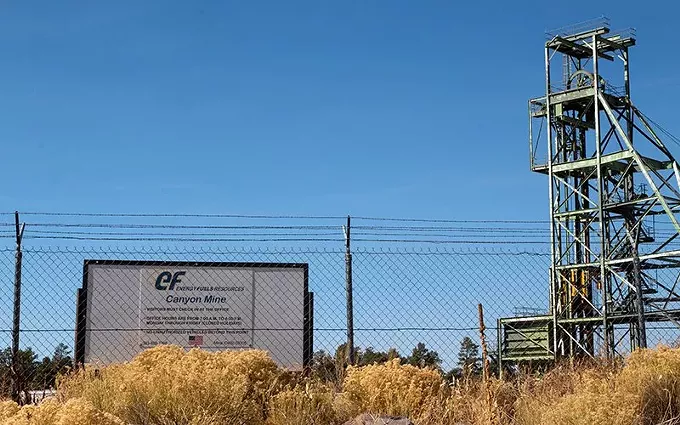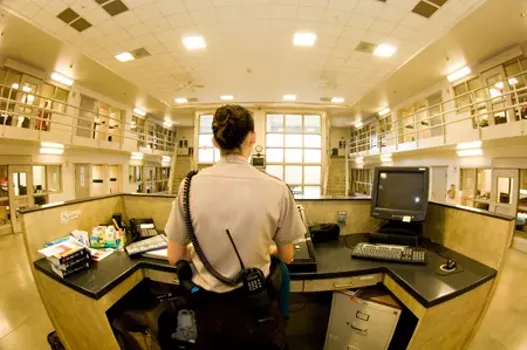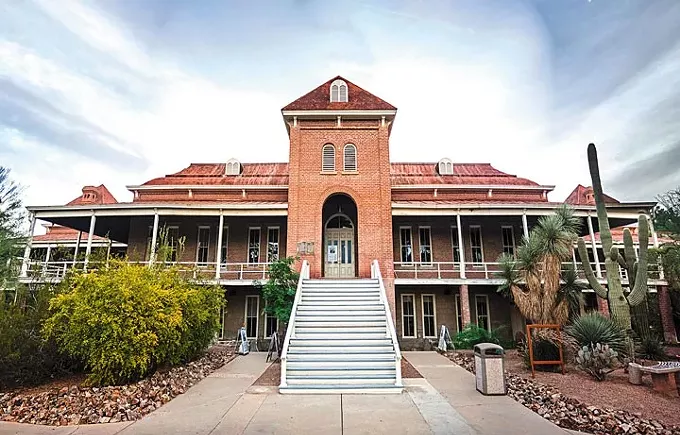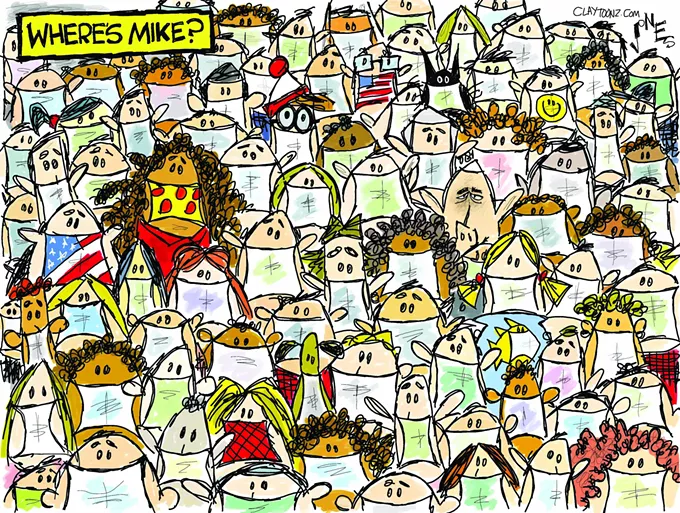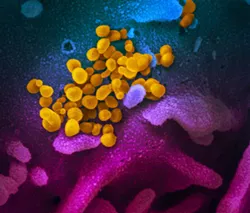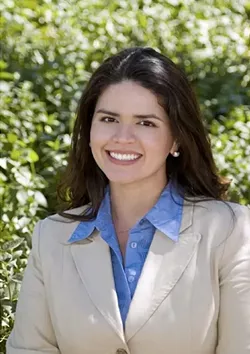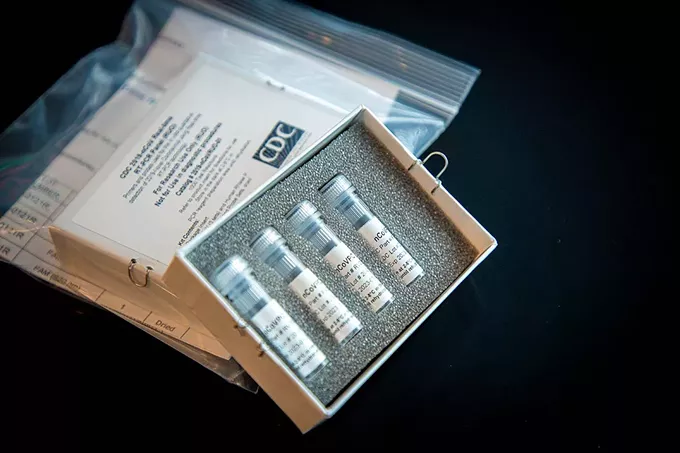Thursday, April 30, 2020
They are responding to a report last week by the Department of Energy’s Nuclear Fuel Working Group, which called for the government to support both uranium mining and nuclear power technology to preserve national security.
The first step in that plan is a proposal for $150 million in next year’s Energy Department’s budget to buy and stockpile U.S.-mined uranium, the report said.
“As a matter of national security, it is critical that we take bold steps to preserve and grow the entire U.S. nuclear energy enterprise,” Energy Secretary Dan Brouillette said in a statement announcing the report. He said a lack of U.S. progress on nuclear energy and technology “has threatened our national interest and national security.”
Environmentalists say there is no need to protect a “sagging” uranium mining industry and fear the report will lead the administration to slash environmental laws and regulations to allow for more mining. That is a particular concern in northern Arizona where there are hundreds of abandoned uranium mines that still pose health risks, they said.
“We cannot turn a blind eye to past mining in the region and incentivize new mining on public lands without even fully remediating environmental and public health hazards already present,” Rep. Tom O’Halleran, D-Sedona, said in a statement responding to the report.
Yesterday the Pima County Sheriff's Department announced that four employees have tested positive for COVID-19.
The employees, including one correctional staff member from the county jail, have been placed on pandemic leave.
The corrections staff member had been away from work for unrelated reasons since April 17, according to a department press release. The employee's immediate coworkers were notified of the positive case and given information about proper contract tracing.
The sheriff's department is confident that no other people were put at risk because the employee was away from work, but this news comes as many criminal justice reform advocates are calling on local, state and federal officials to drastically reduce prison populations because of the increased risk of COVID-19 transmission.
Jails and prisons confine large groups of people together in close spaces, which makes social distancing impossible. There have also been reports of a lack of personal protective equipment and sanitary items available to state prison staff and people incarcerated there.
The sheriff's department stated that no other correctional staff or any incarcerated individuals have tested positive for the virus.
"During this unprecedented crisis, the Pima County Sheriff's Department will continue to serve the public," the release states. "We will do so in accordance with public health guidance. We will maintain the safest working environment possible for our employees and will continue to ensure the safety of the inmates in our custody."
The coronavirus had killed 320 people statewide, including 80 in Pima County, according to the report. In Maricopa County, the number of confirmed COVID-19 cases had risen to 3,972.
Tags: Pima County Sheriff , Pima County Jail , COVID19 , Coronavirus , Employee , Image
Robbins said this at an event where he had his blood drawn for antibody testing.
Pima County had 1,241 confirmed cases.
The coronavirus had killed 320 people statewide, including 80 in Pima County, according to the report.
In Maricopa County, the number of confirmed COVID-19 cases had risen to 3,972.
Because testing remains limited in Arizona and COVID-19 symptoms can take as long as two weeks to appear after exposure to the virus (while some people can remain entirely asymptomatic), health officials continue to urge the public to avoid unnecessary trips and gatherings of more than 10 people and have advised people to cover their faces with masks in public.
Gov. Doug Ducey announced yesterday that his stay-at-home order would remain in place through May 15 with some modification. The order was set to expire today.
People are still advised to limit contact and many businesses must remain closed, but Ducey said he wanted the state’s economy to gradually reopen.
“These habits we've acquired over the last 45 days will not be with us forever, but they will be with us for the time being,” Ducey said.
Ducey said that he will decide how to move forward based on what future testing shows regarding the spread of the virus, but explained it would be a gradual reopening of businesses now closed.
The governor added that some businesses can voluntarily reopen beginning Monday, May 4, as long as they resume physical distancing. The first stage of opening includes appointment-based services, with more businesses included on Friday, May 8.
Ducey's decision won support from both Democrats and business leaders.
“The revisions put forth by the governor breathe needed oxygen into our retail sector," said Glenn Hamer, president and CEO Arizona Chamber of Commerce & Industry. "Stores that sell essential goods have proven already that they can operate safely, and we look forward to more retailers doing the same."
Pima County Supervisor Ramon Valadez, who earlier in the day urged Ducey to be cautious in relaxing restrictions, said Ducey appeared to be taking the right course of action by encouraging people to remain at home but allowing businesses to reopen on a limited basis.
“What he’s doing right now is OK,” Valadez said. “We need to go with science and data and public health so we’re not re-doing the reopening in another month, because that’s what we’re looking at if we don’t do that right.”
Tags: maga , trump , pence , masks , covid19 , political , cartoon , Image
Wednesday, April 29, 2020
“These habits we've acquired over the last 45 days will not be with us forever, but they will be with us for the time being,” Ducey said.
Ducey said that he will decide how to move forward based on what future testing shows regarding the spread of the virus, but explained it would be a gradual reopening of businesses now closed.
The governor added that some businesses can voluntarily reopen beginning Monday, May 4, as long as they resume physical distancing. The first stage of opening includes appointment-based services, with more businesses included on Friday, May 8.
Ducey's decision won support from both Democrats and business leaders.
“The revisions put forth by the governor breathe needed oxygen into our retail sector," said Glenn Hamer, president and CEO Arizona Chamber of Commerce & Industry. "Stores that sell essential goods have proven already that they can operate safely, and we look forward to more retailers doing the same."
“What he’s doing right now is OK,” Valadez said. “We need to go with science and data and public health so we’re not re-doing the reopening in another month, because that’s what we’re looking at if we don’t do that right.”
Valadez added that vulnerable populations such as seniors or people with underlying health issues avoid going out in public as much as they could.
Ducey said that he working to allow restaurants to begin serving more than takeout and delivery in the near future but bars would remain closed for a longer period.
Arizona Restaurant Association President and CEO Steve Chucri said he had been working with Ducey to develop ways to safely reopen eateries.
“We appreciate the governor’s thoughtful and inclusive approach," Chucri said in a prepared statement. "And though we are not ready to open today, by working together we will get there soon.”
Tucson Mayor Regina Romero said Ducey was moving in the right direction.
“I am encouraged by Governor Ducey’s extension of his ‘Stay Home, Stay Healthy, Stay Connected’ Executive Order and applaud his measured approach,” Romero said in a prepared statement. “These are difficult but necessary decisions that no elected official relishes making.”
Romero said that she wanted to ensure that Tucsonans are safe from COVID-19 in the workplace and the marketplace before the stay-at-home order is lifted.
"Every day that our local businesses remain closed and our workers without jobs pains me,” Romero said. “I am as eager as anyone to begin gradually re-opening our economy, however we must do so in a manner that is safe and consistent with the advice of public health experts. It is critical that a phased-in re-opening follows the guidelines established by the CDC, and locally by the Pima County Health Department. To date, Arizona and Pima County have not met this criteria."
Romero added that she wanted to work with Ducey and state officials before lifting more restrictions.
“Given that the Executive Order pre-empts municipalities from taking action at the local level, I would highly advise Governor Ducey to seek the input of Mayors and local elected officials who are on the frontlines of this pandemic," she said. "I look forward to working with Gov. Ducey to promote the safety and well-being of Arizonans during these difficult times.”
Tucson City Councilman Steve Kozachik likewise said it was important that local jurisdictions have the authority to set their own protocols regarding the outbreak.
“We need to follow science and not put our city at greater risk of reversing any slight perceived gains we may have achieved,” Kozachik said.
House Democratic Leader Charlene Fernandez (D-Yuma) said it was a "good decision" to extend the modified stay-at-home order. She said the state should follow CDC criteria for reopening the state and called for more testing.
"Arizona does not yet meet all of these standards—while our healthcare system appears to have capacity, our curve of infection is not yet bent—so it was a good decision to extend Arizona’s stay-at-home order until May 15 with modifications," Fernandez said. "Gov. Ducey said that Arizona is heading in the right direction, and we certainly hope that is the case, but we need more tests and more decreasing trendlines."
Ducey’s announcement came on the same day that the state’s confirmed cases topped 7,200, with 304 people dead after contracting the virus. A total of 80 people have died from COVID-19 in Pima County, which was home to 1,215 of the state's 7,202 confirmed cases, according to the Arizona Department of Health Services.
Ducey has been criticized by some Arizona conservatives for the stay-at-home order, but a late April poll by Public Opinion Strategies showed that most Arizonans approved of the effort to slow the outbreak. Roughly six in 10 voters thought his approach had been “just about right,” while 29 percent said he had “not gone far enough” and just 8 percent said he had “gone too far,” according to the poll of 600 registered voters.
Ducey issued the initial stay-at-home order on Monday, March 30, ordering the closure of “non-essential” businesses, but critics said he allowed too many businesses to remain open. As the virus continued its spread, Ducey later trimmed the list of “non-essential” businesses, forcing barber shops, beauty salons, swap meets and similar businesses to shut down.
Hundreds of thousands of Arizonans have lost their jobs since the outbreak began, with more than 420,000 people applying for unemployment benefits in recent weeks. Even many businesses that have been able to keep their doors open have experienced sharp drops in revenue. State budget forecasters have said the state could be facing a billion-dollar budget shortfall but advised that with so little data to work from, they could be off by $500 million in either direction.
Jim Nintzel and Austin Counts contributed to this report, which has been updated with reaction throughout the day.
“In order to ensure special access to the PPP loan program for the smallest lenders and their small business customers, the SBA is only accepting loans from lending institutions with asset sizes less than $1 billion from 4 p.m. EDT until 11:59 p.m. EDT on April 29, 2020. SBA is working to ensure that all eligible small businesses have access to this funding to sustain their businesses and keep their employees on payroll," according to a joint statement by U.S. Small Business Administration Administrator Jovita Carranza and U.S. Treasury Secretary Steven T. Mnuchin.
The special access to smaller lenders also expected to help the SBA's future "loan system performance" to other lenders submitting PPP applications after today, according to the release.
Larger lenders are still able to submit their client's PPP loans during and after today's timeframe.
For more information on applying for PPP loans, click here.
The joint statement was issued less than an hour before Ducey is scheduled to speak at a press conference with other state officials regarding his stay-home order, which is set to expire at the end of the day tomorrow.
The three mayors said they have received no guidance from Ducey’s office with just over one day left on the order—and urged the governor to adhere to the guidelines established by the CDC and the federal government.
“The state must be able to provide clear data showing that we have achieved a 14-day decline in COVID cases before the economy begins to reopen,” the statement reads.
The federal government’s “Opening Up America Again” program includes a list of criteria states need to meet before beginning to reopen, including a downward trajectory of influenza-like and COVID-19 cases for two weeks, having “robust testing” in place and a sufficient supply of PPE.
The joint statement also gives credit to Ducey for expanding testing to greater segments of the population, as that data will be “critical in determining our ability to safely reopen the economy without unnecessary imperiling the lives of our residents.”
“We are all eager to reopen the economy as soon as it is safe to do so,” the statement reads. “We again ask the governor to work closely with cities on COVID resiliency efforts. Our cities’ first responders are tasked with carrying out any statewide executive orders and the more time they have to prepare the better chance we have to keep our police, fire, and residents safe and healthy.”
Gov. Ducey is expected to deliver remarks alongside the Arizona Department of Health Services Director Dr. Cara Christ and Arizona Department of Emergency and Military Affairs Director Major General Michael T. McGuire at 3 p.m. and provide an update on the state’s actions in response to COVID-19.
Pima County and the City of Tucson are united in our concern on relaxing restrictions and opening up our economy at this time. We encourage Governor Ducey to give counties and local jurisdictions the flexibility to act at the regional level if he does not want to extend his 'Stay Home, Stay Healthy, Stay Connected' executive order statewide.
The CDC’s guidelines on 'Opening Up America Again' clearly state that Governors have the discretion to allow local jurisdictions to act at the regional level. The Pima County Health Department has issued guidelines based off CDC recommendations on when it is safe to begin a phased re-opening, including a decline of positive cases over 14 consecutive days, widespread testing, and sufficient PPE for first responders and healthcare workers. We urge great caution in any relaxation.
In the past two weeks, researchers across America have begun announcing results from studies showing that there have been many more coronavirus infections in their communities than were previously recorded.
Findings have come in from Santa Clara County, California, as well as Los Angeles, New York, Chelsea, Massachusetts, and Miami-Dade County, Florida. The debates began immediately. What did the study results actually mean? If more people were infected than previously known, did that mean the death rate is actually lower than previously thought? Is the coronavirus actually more like the flu, after all? And are we close to “herd immunity,” meaning enough people are infected that the virus won’t spread easily anymore?
These studies all were based on antibody tests, which are diagnostics that can look in a person’s blood and see if there is evidence of prior infection. In the past month, as these tests have reached the market, researchers have launched large-scale studies, known as sero-surveys (sero is short for serology, the study of blood serum). By running these surveys, scientists are finally able to start estimating how many people have been infected, which can give us information about how deadly the disease is and where the disease was most concentrated geographically.


